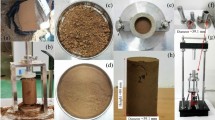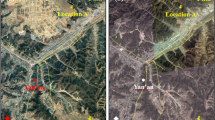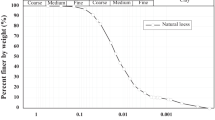Abstract
Loess is found all over the world, accounting for about 10 % of the world’s total land area. This soil exhibits a distinctive behavior that is related to their formation history, mineralogy, and microstructure, which can cause serious geotechnical engineering problems. This paper presents the microstructural evolution of the subgrade loess of the Baozhong railway in Guyuan. Particularly, the collapse potential, shear behavior, and the influence of microstructure on them are experimentally studied. The results reveal that the top loess contains more clay content, and the grains with a size of 1–20 μm are significantly more than those of the middle loess and the bottom loess. These particles usually have the effect of combining quartz, feldspar, and other particles. In addition, the macroscopic mechanical properties of top loess are more influenced by intergrains cementation bonds and are more sensitive to water. As a comparison, the middle and bottom loess are more influenced by its loose interstructure and are more sensitive to compression. Based on the analysis of microstructure, a cyclic process model which link the pore change and particle packing is proposed. It is demonstrated that the particle packing is closely related to the change of pores. While the pores decrease to a minimum, the particle packing changes to a bridged random close packing. This mechanism can be used to explain the uneven settlement of the Baozhong railway subgrade in Ningxia.











Similar content being viewed by others
References
Allen JRL (1982) Sedimentary structures: Their character and physical basis, Volume 1, vol 2
Assadi-Langroudi A, Ng'ambi S, Smalley I (2018) Loess as a collapsible soil: some basic particle packing aspects. Quat Int 469:20–29. https://doi.org/10.1016/j.quaint.2016.09.058
Assallay AM, Rogers CDF, Smalley IJ (1997) Formation and collapse of metastable particle packings and open structures in loess deposits. Eng Geol 48(1):101–115. https://doi.org/10.1016/S0013-7952(97)81916-3
Chen C, Gao P, Hu Z (2006) Moistening deformation characteristic of loess and its relation to structure. Yanshilixue Yu Gongcheng Xuebao/Chinese Journal of Rock Mechanics and Engineering 25(7):1352–1360
Dang J (1998) The construction strength of unsaturated loess and its use. Acta Agriculturaeoreali-Occidentalis Sinica 26(5):48–51
Dang JQ, Li J (2001) The structural strength and shear strength of unsaturated loess. J Hydraul Eng 7:79–83
Delage P, Audiguier M, Cui Y-J, Howat MD (1996) Microstructure of a compacted silt. Can Geotech J 33(1):150–158. https://doi.org/10.1139/t96-030
Delage P, Cui Y-J, Antoine P (2005) Geotechnical problems related with loess deposits in northern France. Proceedings of international conference on problematic soils
Derbyshire E (2001) Geological hazards in loess terrain, with particular reference to the loess regions of China. Earth Sci Rev 54(1):231–260. https://doi.org/10.1016/S0012-8252(01)00050-2
Dijkstra TA, Smalley IJ, Rogers CDF (1995) Particle packing in loess deposits and the problem of structure collapse and hydroconsolidation. Eng Geol 40(1):49–64. https://doi.org/10.1016/0013-7952(95)00022-4
Dijkstra T, Van Asch TWJ, Rappange FE, Meng X (2000) Modelling landslide hazards in loess terrain. Landslides in the Thick Loess Terrain of North-west China, 131–172
Dudley JH (1970) Review of collapsing soils. J Soil Mech Found Div 96(3):925–947
Gao G (1980) Chinese loess microstructure. Chin Sci Bull 25(20):945–948
Gaver W (2012) What should we expect from research through design? Paper presented at the Conference on Human Factors in Computing Systems – Proceedings. https://doi.org/10.1145/2207676.2208538
Guo JY (1958) Study on the reasons for collapse. Hydrogeology and Engineering Geology 4:7–11
Guorui G (1981) Classification of microstructures of loess in China and their collapsibility. Scientia Sinica (Vol. 24)
Houston SL, Houston WN, Zapata CE, Lawrence C (2001) Geotechnical engineering practice for collapsible soils. Geotech Geol Eng 19(3):333–355. https://doi.org/10.1023/A:1013178226615
Hu F (2005) Treatment of foundation of wet sinking loess. City Bridge and Flood 1:97–98
Hu RL, Yeung MR, Lee CF, Wang SJ (2001) Mechanical behavior and microstructural variation of loess under dynamic compaction. Eng Geol 59(3):203–217. https://doi.org/10.1016/S0013-7952(00)00074-0
Jiang M, Zhang F, Hu H, Cui Y, Peng J (2014a) Structural characterization of natural loess and remolded loess under triaxial tests. Eng Geol 181:249–260. https://doi.org/10.1016/j.enggeo.2014.07.021
Jiang MJ, Li T, Hu HJ, Thornton C (2014b) DEM analyses of one-dimensional compression and collapse behaviour of unsaturated structural loess. Comput Geotech 60:47–60
Koliji A, Lehmann P, Vulliet L, Laloui L, Carminati A, Vontobel P, Hassanein R (2008) Assessment of structural evolution of aggregated soil using neutron tomography. Water Resour Res 44(5). https://doi.org/10.1029/2007wr006297
Li P, Vanapalli S, Li T (2016) Review of collapse triggering mechanism of collapsible soils due to wetting. J Rock Mech Geotech Eng 8(2):256–274. https://doi.org/10.1016/j.jrmge.2015.12.002
Liu TS (1985) Loess and the environment. China Ocean Press, 1–481
Lommler JC, Bandini P (2015) Characterization of collapsible soils. In IFCEE 2015, pp 1834-1841
Luo H, Wu F, Chang J, Xu J (2018) Microstructural constraints on geotechnical properties of Malan loess: a case study from Zhaojiaan landslide in Shaanxi province, China. Eng Geol 236:60–69. https://doi.org/10.1016/j.enggeo.2017.11.002
Monroy R, Zdravkovic L, Ridley A (2010) Evolution of microstructure in compacted London clay during wetting and loading. Géotechnique 60(2):105–119. https://doi.org/10.1680/geot.8.P.125
Muñoz-Castelblanco JA, Pereira JM, Delage P, Cui YJ (2012) The water retention properties of a natural unsaturated loess from northern France. Géotechnique 62(2):95–106. https://doi.org/10.1680/geot.9.P.084
Nolan GT, Kavanagh PE (1992) Computer simulation of random packing of hard spheres. Powder Technol 72(2):149–155. https://doi.org/10.1016/0032-5910(92)88021-9
Nouaouria MS, Guenfoud M, Lafifi B (2008) Engineering properties of loess in Algeria. Eng Geol 99(1):85–90. https://doi.org/10.1016/j.enggeo.2008.01.013
Osipov VI, Sokolov VN (1995) Factors and mechanism of loess collapsibility. In: Derbyshire E, Dijkstra T, Smalley IJ (eds) Genesis and properties of collapsible soils. Springer Netherlands, Dordrecht, pp 49–63. https://doi.org/10.1007/978-94-011-0097-7_4
Peng J-B (2006) Ground fissure: the major geological and environmental problem in the development of Xi'an city. Environ Sci Technol 2:469–474
Rogers CDF, Dijkstra TA, Smalley IJ (1994) Particle packing from an earth science viewpoint. Earth Sci Rev 36(1):59–82. https://doi.org/10.1016/0012-8252(94)90008-6
Romero E, Simms PH (2008) Microstructure investigation in unsaturated soils: a review with special attention to contribution of mercury intrusion porosimetry and environmental scanning electron microscopy. Geotech Geol Eng 26(6):705–727. https://doi.org/10.1007/s10706-008-9204-5
Ryashchenko TG, Akulova VV, Erbaeva MA (2008) Loessial soils of Priangaria, Transbaikalia, Mongolia, and northwestern China. Quat Int 179(1):90–95. https://doi.org/10.1016/j.quaint.2007.06.035
Shao X, Zhang H, Tan Y (2018) Collapse behavior and microstructural alteration of remolded loess under graded wetting tests. Eng Geol 233:11–22. https://doi.org/10.1016/j.enggeo.2017.11.025
Simms ERPH (2008) Microstructure investigation in unsaturated soils: a review with special attention to contribution of mercury intrusion porosimetry and environmental scanning electron microscopy. Geotech Geol Eng 26(6):705–727
Smalley IJ, Vita-Finzi C (1968) The formation of fine particles in sandy deserts and the nature of 'desert' loess. J Sediment Petrol 38(3):766–774
Smalley IJ, Jefferson IF, Dijkstra TA, Derbyshire E (2001) Some major events in the development of the scientific study of loess. Earth Sci Rev 54(1):5–18. https://doi.org/10.1016/S0012-8252(01)00038-1
Sun P (2010) Reply to the discussion by Ling Xu on “weak tensile characteristics of loess in China — an important reason for ground fissure” by ping Sun, Jian-Bing Peng, Li-Wei Chen, Yue-ping Yin and Shu-Ren Wu, [engineering geology 108 (2009) 153–159]. Eng Geol 114(1):107. https://doi.org/10.1016/j.enggeo.2010.04.008
Sun P, Peng J-B, Chen L-W, Yin Y-P, Wu S-R (2009) Weak tensile characteristics of loess in China — an important reason for ground fissures. Eng Geol 108(1):153–159. https://doi.org/10.1016/j.enggeo.2009.05.014
Susan D (2017) A microstructural model for collapsing soils. Nottingham Trent University (United Kingdom)
Terzaghi K, Peck RB (1996) Soil mechanics in engineering practice, third edn. Wiley, New York
Wen B-P, Yan Y-J (2014) Influence of structure on shear characteristics of the unsaturated loess in Lanzhou, China. Eng Geol 168:46–58. https://doi.org/10.1016/j.enggeo.2013.10.023
Xie W-L, Li P, Zhang M-S, Cheng T-E, Wang Y (2018) Collapse behavior and microstructural evolution of loess soils from the loess plateau of China. J Mt Sci 15(8):1642–1657
Yang YL (1988) Study of the mechanism of loess collapse. Science in China (Series B)(7):756-766
Ye W, Yang G, Peng J, Huang Q, Xu Y (2012) Test research on mechanism of freezing and thawing cycle resulting in loess slope spalling hazards in Luochuan. Yanshilixue Yu Gongcheng Xuebao/Chinese Journal of Rock Mechanics and Engineering 31(1):199–205
Yuan JX (2009) The analysis of triggering factors of loess collapsibility. J West-China Exploration Engineering 31:31–34
Zhang Y, Hu Z, Li L, Xue Z (2018) Improving the structure and mechanical properties of loess by acid solutions – an experimental study. Eng Geol 244:132–145. https://doi.org/10.1016/j.enggeo.2018.07.023
Zhao S, Lei Y (2011) The autonomous robot object recognition algorithm based on multi-feature fusion. Paper presented at the 2011 international conference on electric information and control engineering, ICEICE 2011 - proceedings. https://doi.org/10.1109/ICEICE.2011.5777691
Zhuang J, Peng J, Wang G, Javed I, Wang Y, Li W (2018) Distribution and characteristics of landslide in loess plateau: a case study in Shaanxi province. Eng Geol 236:89–96
Author information
Authors and Affiliations
Corresponding author
Rights and permissions
About this article
Cite this article
Meng, Z., Liyi, C., Shanyong, W. et al. Experimental study of the microstructure of loess on its macroscopic geotechnical properties of the Baozhong railway subgrade in Ningxia, China. Bull Eng Geol Environ 79, 4829–4840 (2020). https://doi.org/10.1007/s10064-020-01816-9
Received:
Accepted:
Published:
Issue Date:
DOI: https://doi.org/10.1007/s10064-020-01816-9




